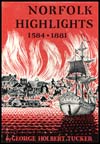Chapter 44
Norfolk's Civil War Phase
The storm clouds of the Civil War began to gather over Norfolk as early as November 10, 1860, when the Daily Southern Argus, the city's "states' rights" paper editorialized:
"Sooner or later the ties which now link together the North and South must be sundered. How closely the inevitable effect will follow the cause, may be a matter of speculation, but it can only be a matter of time. When those shall govern the confederacy who pronounce Southern life utter 'barbarism,' and denounce as 'the sum of all villanies' a practice on which our whole section sustains itself, the South must secede if secession is practicable."
But there were those in Norfolk who felt otherwise. A correspondent to the Herald and Norfolk and Portsmouth Advertiser suggested that Virginia cast her lot with the North rather than the cotton states. "Their slave property," he wrote, "both by the duty and policy of the free States, would be secured, until it could be gotten rid of by gradual sales. There would be, on the part of the free States, a cordial and sincere co-operation in this scheme."
Such were the two schools of thought in Norfolk on the eve of the war. But as time passed, the more radical Southern attitude prevailed.
On December 20, 1860, when South Carolina seceded from the Union, the Herald, strongly Unionist in sentiment, asked why Virginia should "dance crazily out of the Union to the fiddling of South Carolina?"
But the Argus applauded the act by trumpeting, "Right nobly the proud and brave sons of South Carolina met the emergency. At one stroke they have severed the chains which bind them to a tyrannous North, and they now stand before the world an independent people."
South Carolina's move was followed in rapid succession by Mississippi, Florida, Alabama, Georgia, Louisiana, and Texas. Finally, when President Lincoln called for volunteers to put down the rebellion, Virginia voted to secede from the Union on April 17, 1861.
Prior to this, Southern sentiment was rapidly gaining the upper hand in Norfolk, and one impatient citizen had already unfurled the Confederate flag, with its seven stars encircling the letters "Va.," from the roof of a house on Wolfe Street on April 2, 1861. This was followed on April 12, 1861, by a party of young enthusiasts who sailed down the river to Craney Island and hoisted the same colors over the old blockhouse there.
With the secession of Virginia, followed rapidly by Arkansas, North Carolina, and Tennessee, the die was cast and life in Norfolk marched to a quicker pace as its citizens prepared for war. From then on, Norfolk's Confederate history blazed bravely, if briefly.
At 3:20 a.m. on April 21, 1861, the Gosport Navy Yard containing millions of dollars of naval stores and arms, together with several naval vessels moored in the Elizabeth River, were put to the torch by the evacuating Federal forces. According to one contemporary account, "The scene was grand and terrific beyond description. The roar of the conflagration was loud enough to be heard at three or four miles distance, and to this were added occasional discharges from the heavy guns of the old Pennsylvania."
One of the vessels that was partially burned was the new steam frigate, the USS Merrimack, then regarded as the "Queen of the Navy." What was left of her was later converted into the CSS Virginia that locked horns with the USS Monitor on March 9, 1862, in the first battle between ironclads, the grand finale of Norfolk's Confederate phase.
On May 10, 1862, Federal forces recaptured Norfolk, the Merrimack was scuttled and blown up by her crew early the next morning, and the United States flag again flapped atop the Corinthian portico of the Customs House on Main Street.
Chapter
45
Virginia's First Civil War Engagement
Norfolk Highlights 1584 - 1881

See the "Table of Contents" for links to every chapter in Norfolk Highlights 1584 - 1881 by George Holbert Tucker.
